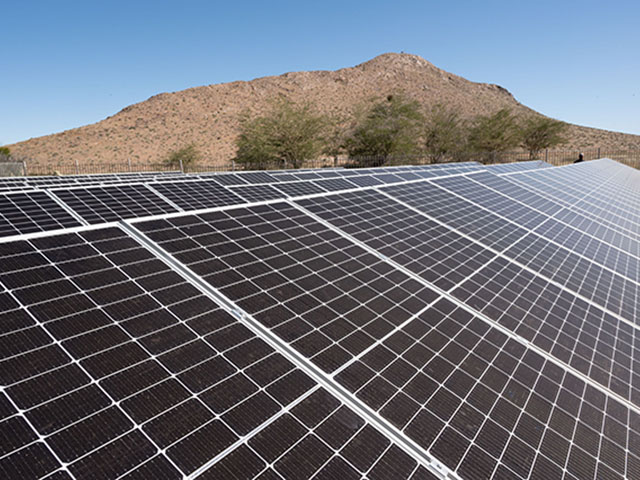WSP helps Vedanta
By Staff Writer 3 October 2023 | Categories: news
In the past few years, environmental responsibility has become a high priority for mines, as they have been tasked with ensuring that their operations are sustainable and kinder to the environment.
Vedanta Zinc International, the owner of Black Mountain Mining (BMM), is driven by their purpose to Transform for Good (Workplace, Planet and Community) and Going Beyond – and achieving a Net Zero Carbon level rating for the mine's White Office was underpinned by this purpose.
The company appointed WSP in Africa’s sustainability specialist consultants to assist in this, which was a natural choice, as they have previously worked with the company.
''BMM wanted to use our services for the Net Zero initiative as we are very experienced in sustainability ratings in South Africa. For instance, WSP was responsible for one of the first pilot projects for Net Zero Carbon and has completed two other Net Zero Carbon projects in the last two years,"' says Alison Groves, the Regional Director of WSP in Africa.
BMM had an ambitious goal, of achieving a Net Zero Carbon Level 2 rating. This stringent certification is based on actual measured values, as opposed to modelled values as required for the Level 1 certification.
“The Green Building Council of South Africa (GBCSA) offers two approaches at present. Under Level 1, Net Zero Carbon is calculated on the base building energy demand which is generated through energy modelling of the building. Where Level 2 encompasses the actual modelled renewable energy that is manufactured and consumed. The energy consumption takes account of both the base building needs and the tenant's operational needs. This is a more accurate reflection of whether the building is performing as a Net Zero entity,” Groves explains.
To achieve this, WSP began by assessing the types of air conditioning, lighting and water systems that were installed throughout the building. A key finding of the assessment was that the consumption of utility services wasn’t being measured, and that the energy costs for the town were being settled by BMM, without passing any of the cost onto their employees. There was also no monitoring of consumption through municipal meters, so the company did not know how much power was being consumed.
“Since you cannot manage what you cannot measure, the first step towards achieving Net Zero in the offices was to install a metering system and gain an understanding of how much energy was being used by the office and residential units. This enabled us to calculate the benefit of the solar installation,” says Groves.
Pursuing the Net Zero Carbon Level 2 rating was an ambitious undertaking, given the scope of what needed to be covered. The 422 square meter office complex consists of a collection of single-storey buildings housing 22 private offices, a reception and waiting area, a large meeting/conference room, a training room, kitchen and bathrooms. Additionally, each office has air conditioning.
The next step was to install a 99 kW ground mounted Photovoltaic Solar system (PV), tied to the grid without a battery backup.
Groves notes that at the time 99kW was the maximum permitted installation without having to undergo an onerous licensing procedure, where the legislation has since changed.
“Because there is no battery storage installed as part of the PV system, the sizing of Photovoltaic installation was designed to exceed the annual energy demand of the office complex. As the energy is not stored, the system is designed to continue to generate electricity, over and above the needs of the office,” says Groves. “This generated a unique opportunity to continue to serve the community in which it operates, by feeding the balance of the renewable energy to the nearby residences and create an energy bank of sorts. This surplus energy that is accrued by the residential buildings, could then be claimed by the office complex when solar production does not meet the office’s energy needs.”
To see how well the solution worked and as a requirement for attaining the Level 2 certification, WSP monitored how much renewable energy was generated over twelve months and compared it to the energy requirements of the office complex. This analysis, performed from May 2022 till April of this year, showed that while the total annual energy consumption of the office complex was 193 008 kg CO2/kWh, the total annual output of the solar PV plant far exceeded that, producing 251 065 kg CO2/kWh. This meant that the solar plant was generating enough renewable energy to offset 130% of the office complex’s annual carbon emissions.
It also far exceeded the 5% required by the Green Star Net Carbon rating to demonstrate that the building is now Net Positive.
The success of the project not only enabled BMM to meet its goals, but it also showed just how attainable the Green Star Net Zero rating is for committed mines.
“The Green Star Net Zero Carbon rating is especially important in our world where buildings are striving to reduce their energy consumption and source 100% of the electricity requirements from renewable energy. This is an important use case and benchmark in the local market, as it bodes well for other mine operators that want to serve both the environment and the communities in which they operate, with a future ready approach to their ESG commitments and sustainable business practices,” concludes Groves.
Most Read Articles

Have Your Say
What new tech or developments are you most anticipating this year?



